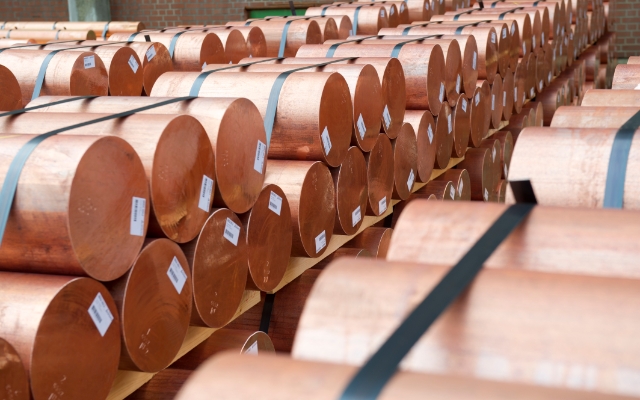Exactly How Copper Products Add To Sustainable Practices in Numerous Sectors
Copper items are progressively recognized for their considerable payments to lasting methods throughout multiple sectors, driven by their intrinsic residential properties such as longevity, effectiveness, and recyclability. In renewable resource systems, for instance, copper improves the functionality of solar and wind modern technologies, while its application in building and construction decreases waste via longevity. Furthermore, the material's antimicrobial characteristics provide promising advantages in health care setups. As sectors look for to adopt more lasting techniques, the duty of copper might verify essential in accomplishing environmental goals. What effects might this have for future developments in sustainability?
Copper in Renewable Energy
Copper plays a critical function in the advancement of renewable resource technologies, acting as an important conductor in various applications. Its exceptional electrical conductivity and resistance to deterioration make it an excellent material for electric circuitry, which is important in photovoltaic panels, wind turbines, and power storage space systems. In solar photovoltaic systems, copper is utilized in the interconnections and circuitry, making it possible for reliable energy conversion from sunshine to electrical energy.
In wind energy, copper is indispensable to the generators and transformers that convert kinetic power into electrical energy, making sure optimal efficiency and reliability. The demand for electric lorries (EVs) is increasing, with copper being an essential element in batteries, electric motors, and charging infrastructure. The shift to EVs dramatically improves the need for copper, as these lorries commonly make use of four times much more copper than traditional interior burning engine lorries.
As the globe looks for to minimize climate modification and change to lasting power sources, copper's duty becomes progressively crucial. The material not only enhances the efficiency and toughness of eco-friendly energy systems however likewise supports the wider goal of reducing greenhouse gas exhausts and promoting a lasting future.
Eco-Friendly Building Products
In the last few years, there has been a noteworthy change in the direction of the fostering of eco-friendly construction materials in action to growing ecological problems. This adjustment is inspired by the demand for sustainable choices that reduce environmental impacts while maintaining structural stability and visual charm.
Copper, recognized for its resilience and recyclability, has become a crucial player in this field. It can be made use of in roof covering, pipes, and electrical systems, adding to power effectiveness and decreasing waste. Copper's longevity suggests less substitutes over time, additional improving its sustainability account.
In addition, products such as bamboo, reclaimed wood, and recycled steel are getting appeal. These options not only use reduced environmental influence but also promote source conservation. As constructing codes increasingly emphasize sustainability, home builders and architects are incorporating these products into their tasks, fostering innovation in style.
The enhancing adoption of eco-friendly construction materials reflects a more comprehensive commitment to sustainability in the developed atmosphere. By prioritizing these products, the building and construction market can significantly decrease its carbon footprint, align with regulative standards, and support a much healthier ecological community for future generations. This trend notes a crucial action towards an extra lasting future in building.
Copper's Duty in Medical care
Current research studies have actually highlighted the substantial duty of copper in healthcare settings, particularly due to its antimicrobial properties. Copper surface areas have been shown to reduce the visibility of microorganisms, including infections and microorganisms, by as much as 99.9% within a short duration. This remarkable efficacy makes copper published here an invaluable product for high-touch surfaces in medical facilities, such as doorknobs, bed rails, and IV poles, consequently adding to improved infection control steps.
Along with its straight antimicrobial effects, copper additionally plays a role in the broader context of health center sustainability (Copper Products). By incorporating copper into clinical tools and furnishings, medical care facilities can decrease the occurrence of healthcare-associated infections (HAIs), which not only enhances individual results but likewise decreases the expenses connected with extensive healthcare facility stays and added therapies
Furthermore, copper's longevity and recyclability line up with lasting methods, permitting accountable source management. As medical care systems significantly prioritize both person safety and ecological stewardship, the combination of copper items is coming to be more widespread. This twin benefit emphasizes copper's vital payment to a much healthier, safer, and extra lasting health care setting.
Sustainability in Transportation

Additionally, copper's sturdiness and rust resistance add to the durability of transportation framework (Copper Products). In rail systems, for example, copper elements improve the reliability and efficiency of signaling and power systems, important for reducing delays and power usage. In addition, copper's role in renewable resource systems, such as solar and wind, sustains sustainable transportation remedies by providing clean power for electric transit alternatives
Investments in copper innovation not just foster sustainability yet also stimulate financial development and work creation in environment-friendly markets. As industries strive to meet strict ecological laws, the application of copper items in transportation emerges as a crucial method in accomplishing sustainability objectives and promoting a cleaner, more effective future.
Copper and Circular Economic Situation
As the world significantly welcomes sustainability, the role of copper in the round economic situation ends up being ever before extra significant. Copper's inherent residential or commercial properties-- such as its recyclability, longevity, and conductivity-- position it as a vital product in a resource-efficient economic situation. The circular economy aims to decrease waste and make the most of source usage through recycling and reusing products, try these out and copper excels in this regard.
The steel can be reused forever without loss of top quality, making it an ideal candidate for sustainable techniques across numerous fields, including construction, electronics, and sustainable energy. By recuperating and recycling copper from end-of-life products, industries can substantially lower the requirement for virgin materials, thereby lowering ecological effects linked with mining and processing.
In addition, the integration of copper into circular economic climate structures not only conserves resources yet additionally fosters innovation. Services that prioritize copper recycling add to a more sustainable supply chain, enhancing their competitiveness while straightening with regulative needs and customer choices for ecologically liable items.
Final Thought
In verdict, copper products significantly add to sustainable methods throughout numerous industries. Their important role in enhancing renewable resource modern technologies, promoting environmentally friendly building and construction products, sustaining infection control in healthcare, assisting in sustainable transportation, and symbolizing the principles of a round economy underscores the versatility and value of copper. By integrating copper into different applications, sectors can accomplish better effectiveness, decrease ecological influence, and straighten with global sustainability goals, ultimately fostering a more sustainable future.

Copper's exceptional conductivity makes it a preferred material in electric vehicle (EV) systems, enhancing power efficiency and performance. Furthermore, copper's function in sustainable energy systems, such as solar and wind, sustains lasting transportation solutions by offering clean energy for electric transit choices.
Their important function in enhancing renewable power innovations, advertising eco-friendly construction materials, sustaining infection control in medical care, facilitating lasting transport, and personifying the principles of a round economic climate highlights the versatility and significance of copper.